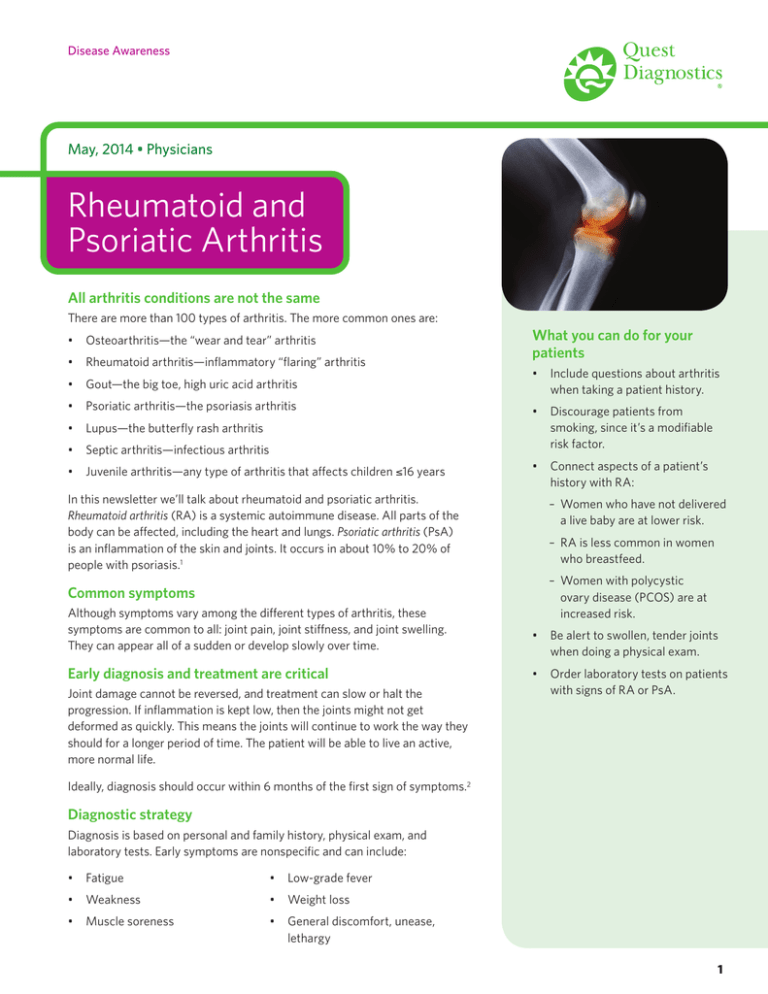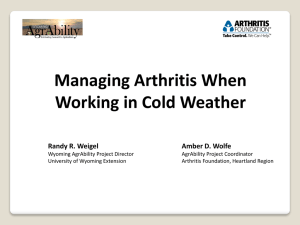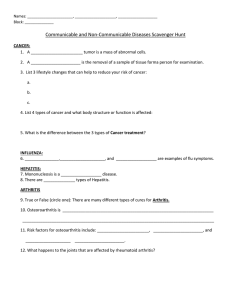
Disease Awareness
May, 2014 • Physicians
Rheumatoid and
Psoriatic Arthritis
All arthritis conditions are not the same
There are more than 100 types of arthritis. The more common ones are:
• Osteoarthritis—the “wear and tear” arthritis
• Rheumatoid arthritis—inflammatory “flaring” arthritis
• Gout—the big toe, high uric acid arthritis
• Psoriatic arthritis—the psoriasis arthritis
• Lupus—the butterfly rash arthritis
• Septic arthritis—infectious arthritis
• Juvenile arthritis—any type of arthritis that affects children ≤16 years
In this newsletter we’ll talk about rheumatoid and psoriatic arthritis.
Rheumatoid arthritis (RA) is a systemic autoimmune disease. All parts of the
body can be affected, including the heart and lungs. Psoriatic arthritis (PsA)
is an inflammation of the skin and joints. It occurs in about 10% to 20% of
people with psoriasis.1
Common symptoms
Although symptoms vary among the different types of arthritis, these
symptoms are common to all: joint pain, joint stiffness, and joint swelling.
They can appear all of a sudden or develop slowly over time.
Early diagnosis and treatment are critical
Joint damage cannot be reversed, and treatment can slow or halt the
progression. If inflammation is kept low, then the joints might not get
deformed as quickly. This means the joints will continue to work the way they
should for a longer period of time. The patient will be able to live an active,
more normal life.
What you can do for your
patients
• I nclude questions about arthritis
when taking a patient history.
• D
iscourage patients from
smoking, since it’s a modifiable
risk factor.
• C
onnect aspects of a patient’s
history with RA:
–– Women who have not delivered
a live baby are at lower risk.
–– R A is less common in women
who breastfeed.
–– Women with polycystic
ovary disease (PCOS) are at
increased risk.
• B
e alert to swollen, tender joints
when doing a physical exam.
• O
rder laboratory tests on patients
with signs of RA or PsA.
Ideally, diagnosis should occur within 6 months of the first sign of symptoms.2
Diagnostic strategy
Diagnosis is based on personal and family history, physical exam, and
laboratory tests. Early symptoms are nonspecific and can include:
• Fatigue
• Low-grade fever
• Weakness
• Weight loss
• Muscle soreness
• G
eneral discomfort, unease,
lethargy
1
Rheumatoid and Psoriatic Arthritis
Physicians
Therefore, the American College of Rheumatology designed criteria
aimed at identifying people with early-stage RA.3 A summary of these
criteria can be found at: QuestDiagnostics.com/hcp/intguide/Immuno/
CF_RheumatoidArthritis.pdf. The criteria include analysis of:
References
• Joint involvement
• Symptom duration
• R
heumatoid factor (RF) and
cyclic citrullinated peptide
(CCP) antibody test results
• C
-reactive protein (CRP) and/or
erythrocyte sedimentation rate
(ESR) test results
2. C
enters for Disease Control and
Prevention. Rheumatoid arthritis. http://
www.cdc.gov/arthritis/basics/rheumatoid.
htm. Accessed March 19, 2014.
Evaluation of a patient for PsA may include a personal and family history
and a physical exam. Helpful laboratory tests include4:
• R
F and CCP antibody to rule out
RA
• H
emoglobin or CBC to test for
anemia
• C
RP and/or ESR to document
inflammation
• I maging (X-ray, MRI, etc.) to
look for signs of joint damage
14-3-3ɳ(eta) protein—a new tool for diagnosis
This protein is released into synovial fluid and blood when there is
inflammation associated with joint erosion. Some early, small studies show
that levels are high in people who have RA. Levels are not high in people
who have psoriasis, osteoporosis, gout, ulcerative colitis, diabetes, lupus,
Crohn disease, Sjögren syndrome, scleroderma, and multiple sclerosis.5,6
Here’s how the 14-3-3ɳ protein compared with RF and CCP antibody tests
in 1 study7:
a
Marker
% Positivea
Rheumatoid factor
48
CCP antibody
56
14-3-3ɳ protein
67
All 3 markers together
81
Percent of 37 patients with early rheumatoid arthritis.
Another small study showed that patients with RA and joint damage had
higher levels of 14-3-3ɳ than those who had RA without joint damage.8 One
more small study showed that the same was true for patients with PsA.9
1.
ease P. Update on treatment of psoriatic
M
arthritis. Bull NYU Hosp Jt Dis. 2012;70:167171.
3. A
letaha D, Neogi T, Silman AJ, et al. 2010
rheumatoid arthritis classification criteria:
an American College of Rheumatology/
European League Against Rheumatism
Collaborative initiative. Arthritis Rheum.
2010;62:2569-2581.
4. A
merican College of Rheumatology.
Psoriatic arthritis. http://www.
rheumatology.org/Practice/Clinical/
Patients/Diseases_And_Conditions/
Psoriatic_Arthritis/. Accessed March 19,
2014.
5. M
aksymowych WP, Landewe R, van
der Heijde D, et al. Serum 14-3-3ɳ: a
rheumatoid arthritis biomarker [abstract].
Arth Rheum. 2011;63(suppl 10):S358.
6. M
arotta A, Landewe R, van der Heijde D, et
al. Serum 14-3-3 eta: a novel biomarker of
rheumatoid arthritis [abstract]. Ann Rheum
Dis. 2011;70(suppl 3):S654.
7. M
arotta A, Bykerk V, Siminovitch KA,
et al. Extracellular 14-3-3ɳ: an early RA
pathogenic factor [abstract]. Arth Rheum.
2011;63(suppl 10):S378.
8. v an der Heijde D, Landewe R, Allaart CF,
et al. 14-3-3 eta is an independent marker
of joint damage that complements CRP
and anti-CCP [abstract]. Ann Rheum Dis.
2012;71(suppl 3):S653.
9. M
arotta A, Kuijk AW, Maksymowych WP,
et al. Serum 14-3-3 eta: an independent
biomarker associated with joint damage in
psoriatic arthritis [abstract]. Ann Rheum
Dis. 2012;71(suppl 3):S576.
A test for 14-3-3ɳ protein is available exclusively from Quest Diagnostics.
You can find more information about this test at QuestDiagnostics.com/
testcenter/TestCenterHome.action.
QuestDiagnostics.com
Quest, Quest Diagnostics, any associated logos, and all associated Quest Diagnostics registered or unregistered trademarks are the property of Quest Diagnostics.
All third party marks - ® and ™ - are the property of their respective owners. © 2014 Quest Diagnostics Incorporated. All rights reserved. 05/2014
2







